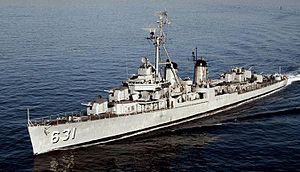This article includes a list of general references, but it lacks sufficient corresponding inline citations. (September 2020) |
 USS Erben underway in the 1950s
| |
| Class overview | |
|---|---|
| Name |
|
| Builders |
|
| Operators | |
| Preceded by | Gleaves class |
| Succeeded by | Allen M. Sumner class |
| Subclasses | |
| Cost | $6 million |
| Built | 3 March 1941 to 22 February 1945 |
| In commission | 4 June 1942 to 1971 (USN), 2001 (Mexico) |
| Completed | 175 |
| Cancelled | 9 |
| Lost | 19, plus 6 not repaired[1] |
| Preserved | |
| General characteristics | |
| Type | Destroyer |
| Displacement | |
| Length | 369.25 ft (112.55 m) wl, 376.5 ft (114.8 m) o/a |
| Beam | 39.5 ft (12.0 m) |
| Draft | 17.5 ft (5.3 m) |
| Propulsion | 60,000 shp (45,000 kW); 4 oil-fired boilers; 2 geared steam turbines; 2 screws |
| Speed | 36.5 knots (67.6 km/h; 42.0 mph) |
| Range | 5,500 nmi (10,200 km; 6,300 mi) at 15 knots (28 km/h; 17 mph)[2] |
| Boats & landing craft carried | 2 × lifeboats |
| Complement | 329 officers and enlisted |
| Sensors and processing systems | |
| Armament | Varied; see § Armament |
The Fletcher class was a class of destroyers built by the United States during World War II. The class was designed in 1939, as a result of dissatisfaction with the earlier destroyer leader types of the Porter and Somers classes. Some went on to serve during the Korean War and into the Vietnam War.[3]
The United States Navy commissioned 175 Fletcher-class destroyers between 1942 and 1944, more than any other destroyer class, and the design was generally regarded as highly successful. The Fletchers had a design speed of 38 knots (70 km/h; 44 mph) and a principal armament of five 5-inch (127 mm) guns in single mounts with ten 21-inch (530 mm) torpedo tubes in two quintuple centerline mounts.[4] The Allen M. Sumner and Gearing classes were Fletcher derivatives.
The long-range Fletcher-class ships performed every task asked of a destroyer, from anti-submarine warfare and anti-aircraft warfare to surface action.[5] They could cover the vast distances required by fleet actions in the Pacific and served almost exclusively in the Pacific Theater of Operations during World War II, during which they accounted for 29 Imperial Japanese Navy submarines sunk.[5][failed verification] In a massive effort, the Fletchers were built by shipyards across the United States, and, after World War II ended, 11 were sold to countries that they had been built to fight against: Italy, Germany, and Japan, as well as other countries, where they had even longer, distinguished careers. Three have been preserved as museum ships in the U.S. and one in Greece.
- ^ destroyerhistory.org: Fletcher class
- ^ "USS Bush-Fletcher class". Retrieved 12 April 2007.
- ^ Friedman, Norman (2004). US Destroyers: An Illustrated Design History (Revised ed.). Annapolis, Maryland: Naval Institute Press. pp. 111–112.
- ^ Friedman p. 472.
- ^ a b Friedman pp. 111–112.